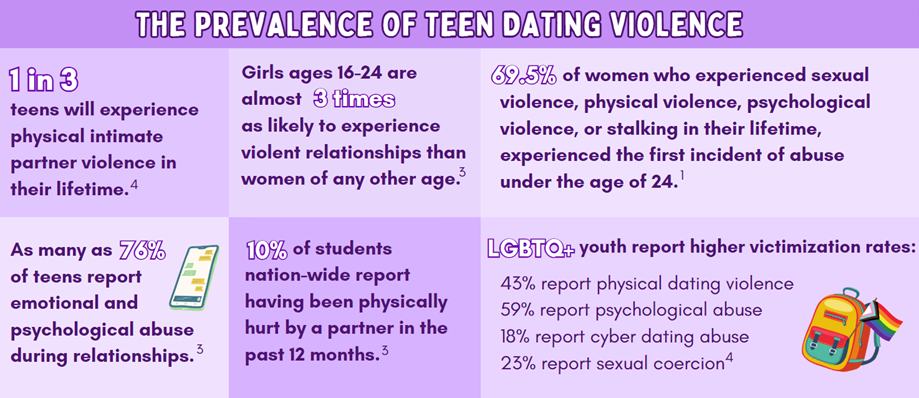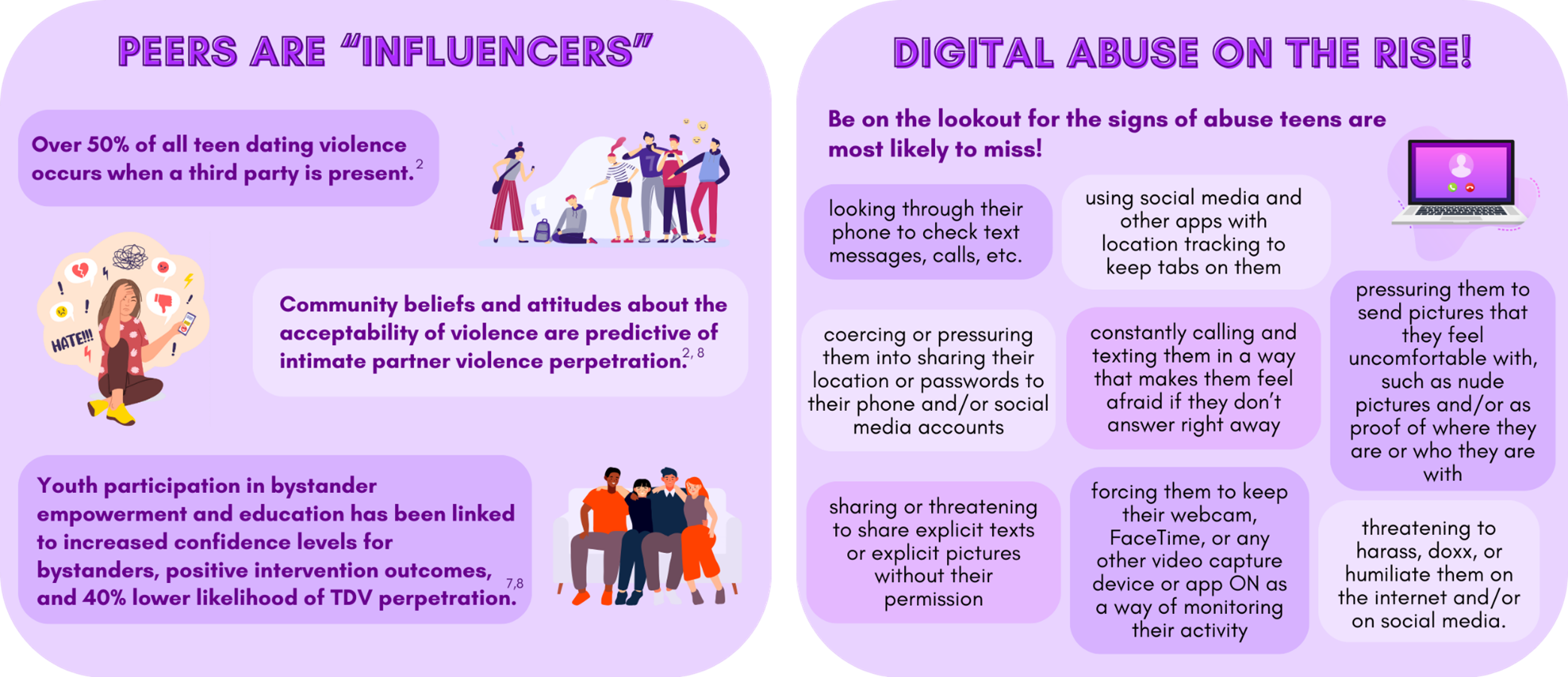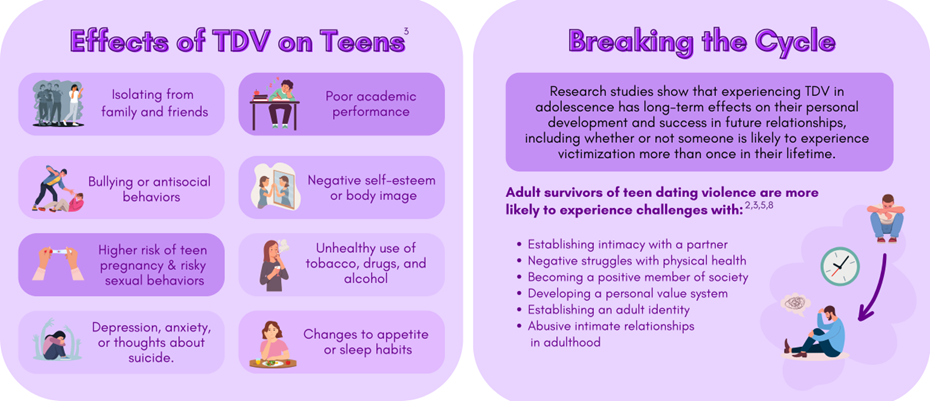What Is Teen Dating Violence?
According to the National Institute of Justice, teen dating violence (TDV) (also known as “intimate partner violence” among adolescents or “adolescent relationship abuse”) includes physical, psychological, emotional, mental, and/or sexual abuse; harassment; or stalking of any person ages 12 to 18 in the context of a past or present romantic or consensual relationship. In practice, there is little difference between domestic violence and dating violence except the typical age ranges affected. Both issues center around an individual seeking to dominate the other through the use of violence, intimidation, and coercive control.
Watch our Dating Abuse 101 video to learn more about what teen dating violence looks like and some of its warning flags.
TOP 5 THINGS to Know about Teen Dating Violence
1.Teen Dating Violence (TDV) is more common than we think
1 in 3 high school student relationships involve physical, emotional, or sexual abuse. Of those affected, only 1 in 3 will ask for help. Understanding how common and prevalent the issue is underscores the importance of raising awareness and making support available to all those impacted by abuse!
2. Friends and peers play a big role in TDV
3. Digital abuse is a growing trend in TDV
Peer attitudes and behaviors are huge influences on a teen’s dating behavior. Teens tells us that they are less likely to challenge abusive behavior if it is considered “normal” by their peers. Many abusive behaviors can be mistaken as normal because teens are still figuring out what healthy romantic relationships should look and feel like. Teens also tells that friends or peers often witness the abuse. Over half of all teen dating violence occurs when a third party is present, and 43% of teen survivors report that the abusive incident occurred in a school building or on school grounds. Teaching friends and peers to be positive bystanders is key to addressing the problem!
4. Having more Conversations about Consent and Sexual Abuse is Essential
Consent is a crucial component of healthy sexual relationships. It involves an agreement between individuals to engage in sexual activity and to respect each other's boundaries without making assumptions. Understanding what consent is and what crosses the line into sexual abuse is essential learning for teens. Consent can be given initially but it can also be withdrawn at any time, no matter where the couple is during any sexual activity. If someone withdraws their consent, sexual activity must stop.
There are certain conditions that must be met for consent to be considered valid:
It is important to note that it is not consent if it is the result of coercion, intimidation, or threat of harm. It is also not consent if a person is incapacitated and unable to make an informed decision about participating in sexual activity. Just because someone is your boyfriend/girlfriend/partner, does not mean they have the right to your body.
5. TDV can have Long-Term Consequences on our Teens
Research suggests that teen dating violence leads to domestic violence in future relationships. These harmful behaviors can have long lasting implications for both survivors and offenders, and unless it is addressed when first presented, the behavior will continue into adulthood.
Educating young adults on what domestic violence is and what it looks like can prevent the cycle of abuse from beginning.
Teenagers lack experience in negotiating the complexities of intimate relationships. If they are unable to communicate in a healthy way, they are at risk for developing poor coping strategies. Peer attitude and behavior are critical influences on a teenager’s dating behavior, and teenagers are less likely to challenge abusive behavior if they are considered normal by their peers. These behaviors tend to be normalized because teenagers do not yet have experience on what healthy romantic relationships should look and feel like.
Would you like to speak to someone about the information above? Our counselors are available to speak 24/7 through our crisis hotline: 201-336-7575. See our Connect With Us tab for more options.
References:
- Black, M.C., Basile, K.C., Breiding, M.J., Smith, S.G., Walters, M.L., Merrick, M.T., Chen, J., & Stevens, M.R. (2011). The National Intimate Partner and Sexual Violence Survey (NISVS): 2010 Summary Report. Atlanta, GA: National Center for Injury Prevention and Control, Centers for Disease Control and Prevention.
- Carrie Mulford, Ph.D.; Peggy C. Giordano, Ph.D., "Teen Dating Violence: A Closer Look at Adolescent Romantic Relationships," October 26, 2008, nij.ojp.gov:
https://nij.ojp.gov/topics/articles/teen-dating-violence-closer-look-adolescent-romantic-relationships - Consequences of teen dating violence | youth. Gov. Retrieved December 22, 2023, from https://youth.gov/youth-topics/teen-dating-violence/consequences
- Dank, M., Lachman, P., Zweig, J.M. & Yahner, J. Dating Violence Experiences of Lesbian, Gay, Bisexual, and Transgender Youth. In Press: Journal of Youth and Adolescence. On-line at http://link.springer.com/article/10.1007/s10964-013-9975-8.
- Davis, Antoinette, MPH. 2008. Interpersonal and Physical Dating Violence among Teens. The National Council on Crime and Delinquency Focus. Available at http://www.nccd-crc.org/nccd/pubs/2008_focus_teen_dating_violence.pdf.
- Development Services Group, Inc. 2022. “Teen Dating Violence.” Literature review. Washington, DC: Office of Juvenile Justice and Delinquency Prevention. https://ojjdp.ojp.gov/model-programs-guide/literature-reviews/Teen-Dating-Violence
- Ricardo, C., Eads, M., & Barker, G. (2011). Engaging boys and young men in the prevention of sexual violence: A systematic and global review of evaluated interventions (p. 72). Sexual Violence Research Initiative. https://www.svri.org/sites/default/files/attachments/2016-04-13/menandboys.pdf
- Youth Risk Behavior Survey: Data Summary & Trends Report 2007-2017 (pp. 1–91). (n.d.). Atlanta, GA: National Center for HIV/AIDS, Viral Hepatitis, STD, and TB Prevention, Centers for Disease Control and Prevention. https://www.cdc.gov/healthyyouth/data/yrbs/pdf/trendsreport.pdf
Contact Us
Marisa Heluk
Director
Division of Alternatives to Domestic Violence
One Bergen County Plaza • 2nd Floor • Hackensack, NJ 07601-7076
Email: ADV@co.bergen.nj.us
24-hour Crisis Hotline: 201-336-7575 • Fax: 201-336-7555
Hours:
Monday - Thursday: 9:00 a.m. - 9:00 p.m.
Friday: 9:00 a.m. - 4:30 p.m.




